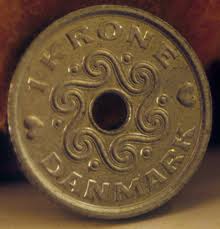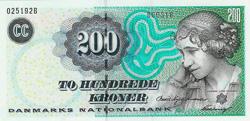|


The króna (plural: krónur) is the currency of the Faroe Islands. It is issued by the Danish National Bank. It is not an independent currency but a version of the Danish krone. Consequently, it does not have an ISO 4217 currency code. The ISO 4217 code for the Danish krone is DKK. The króna is subdivided into 100 oyrur (singular oyra).
History
When German forces occupied Denmark on 9 April 1940, the Danish krone was used in the Faroes. However, all exchange between the Faroes and Denmark halted as a result of the occupation, leaving one currency to develop in two markets independently of each other. On 31 May 1940, special Faroese banknotes were introduced. They consisted of Danish notes with a special stamp. These notes replaced unstamped Danish at par.
From 14 October 1940, new banknotes were printed "on behalf of the National Bank of Denmark". The value of these new banknotes was the same as those already in use. On 18 December 1940, a Currency Central was established in order to monitor foreign trade and to secure the solvency of the Faroes. Currency Central was headed by a board of nine, the judge, who was chairman, one representative of Faroe Fish Export, one representative of the Faroese Merchants' Union, one representative of the bank Føroya Banki, one representative of the savings bank Føroya Sparikassi and four representatives of the Løgting.
On 18 December 1940, the Faroese Króna was pegged to the British pound at a rate of 22.4 krónur = 1 pound. This rate was officially accepted by the British government in a treaty titled "Agreement between His Britannic Majesty's Government and the Administration of the Faroe Islands, for Regulating the Financial Relations between the United Kingdom and the Faroe Islands" which came into force on 27 March 1941. At the same time, the Board of the Currency Central was reorganized to only three members, one representative of the British Government, one representative of the State (referring to the State of Denmark, meaning the County of Faroe), and one representative of the Løgting or the parliamentary National Board. In 1941, coins were struck in London for use on the Faroe Islands.
As of 12 April 1949, the Faroese króna was separated from the pound sterling and fixed to the Danish krone at parity. This arrangement is still in effect. Although Faroese banknotes were issued "on behalf of the National Bank of Denmark", the National Bank of Denmark does not claim any rights to Faroese banknotes issued prior to 1951.
In early August 2009, the Faroe Islands applied to introduce the euro.
Exchange with the Danish krone
Danish kroner are exchanged to Faroese krónur and vice versa by the National Bank of Denmark free of charge. While normal Danish bank notes are no longer intended as legal tender in the Faroes, they are accepted there in most situations. In Denmark proper, existence of the Faroese króna is poorly known, particularly the fact that it is officially the same currency as the Danish krone and that the notes can be exchanged by any Danish bank without charge. Consequently, very few Danish stores will accept Faroese notes. People travelling from the Faroes to Denmark are often advised to exchange their cash prior to embarking in order to prevent potential complications arising from this situation.
Coins
The Faroe Islands use standard Danish coinage, but the region has experienced a shortage of small currency on several occasions, leading to non-standard issues.
During the late 19th century, German national C.F. Siemsen, a merchant conducting business in both the Faroe Islands and Iceland, issued his own private coinage. This issue is brass, one side carrying the inscription: CFS and the other side the denomination: 4 or 16 skilling in goods ("x SKILLING I VARE"). Due to a shortage of currency in 1929-33, two merchants issued their own coins as well; J.F. Kjølbro in Klaksvík and S.P. Petersens Eftf in Fuglafjørður. The Kjølbro issue is aluminium coins with denominations of 10, 25 and 50 øre, and 1, 2, 5, and 10 kroner. S.P. Petersens Eftf's issue was made of brass in denominations of 5, 10 and 25 øre, and 1, 2 and 5 kroner.
5 øre 1941. Although this coin is of the regular Danish type of 1927-40, it was minted in London specifically for use in the Faroe Islands. By 1941, Denmark had switched to aluminium for the 5 øre coins.
During World War II, the Faroe Islands were separated from Denmark proper due to the occupations by the United Kingdom and Germany respectively. In 1941, a set of coins (1, 2, 5, 10 and 25 øre) was minted in London to alleviate a shortage of small change. This issue was identical to the pre-war Danish coinage already circulating, but is easily identified: the coins minted in London were made of bronze and copper-nickel, while the comparable coins minted in Denmark in 1941 were made of aluminium and zinc (with one exception). In addition, the British made set lacks both the mark of the Royal Danish Mint (a small heart) and the initials of the engraver and the mint master in Copenhagen.
Banknotes
In 1940, Danish 5, 20, 50, 100 and 500 kroner notes were overstamped with Kun Gyldig paa Færøerne, Færø Amt, Juni 1940 (meaning Only valid on the Faroe Islands, Faroe County, June 1940) for issue on the Faroe Islands. Later that year, the Færø Amt issued distinct notes in denominations of 1, 5, 10 and 100 kroner. From 1951, notes were issued with texts in Faroese. The 1 kroner note was not continued, with 50 krónur introduced in 1967, followed by 500 and 1000 krónur in 1978, 20 krónur in 1986 and 200 krónur in 2003. Between 2001 and 2005, a new banknote series with new security features was introduced to replace older notes. Denominations are 50, 100, 200, 500 and 1000 krónur.
Numismatics
Postverk Føroya used to be the sole supplier of Faroese banknotes to collectors, but does not sell banknotes anymore.
The text on this page has been made available under the Creative Commons Attribution-ShareAlike License and Creative Commons Licenses
|
